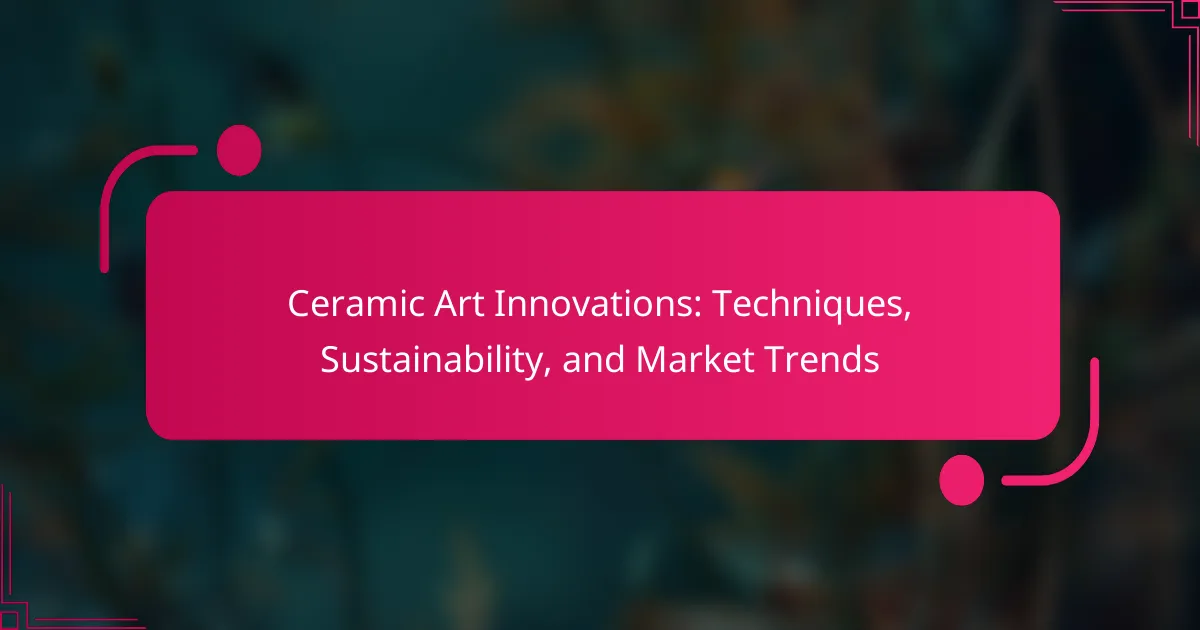Ceramic art is evolving amid rising consumer demand for sustainability and unique craftsmanship. Innovations like 3D printing and digital glazing enhance creativity and efficiency. Eco-friendly materials and energy-efficient practices are becoming standard. Market trends indicate a shift towards handcrafted pieces and direct artist-to-buyer connections.
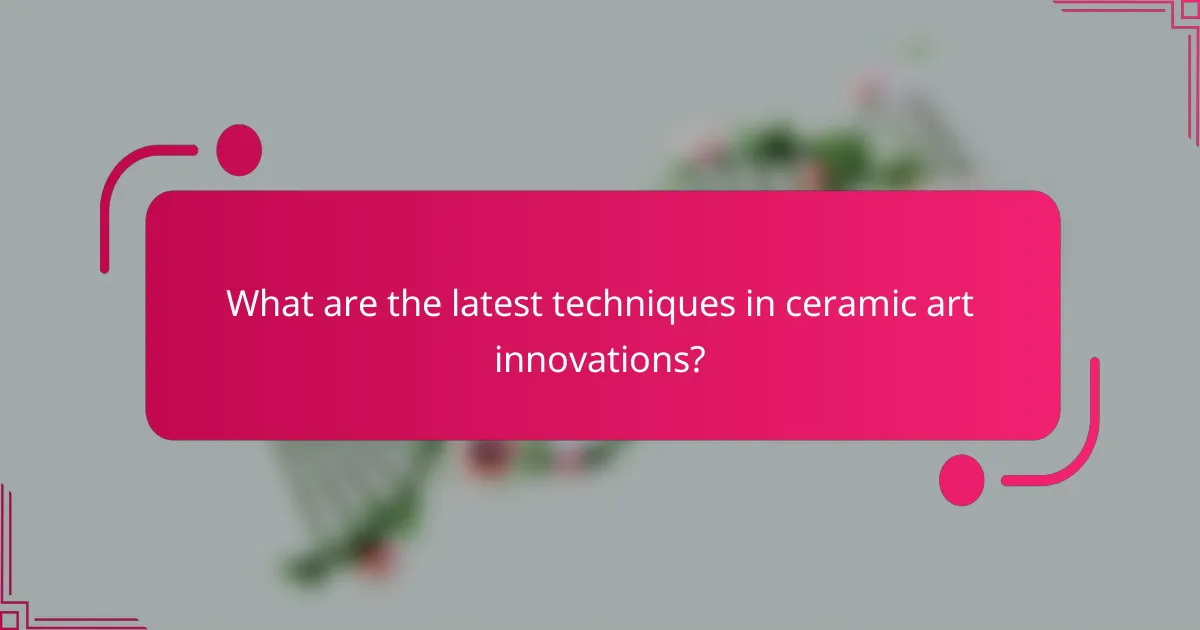
What are the latest techniques in ceramic art innovations?
The latest techniques in ceramic art innovations include 3D printing, digital glazing, and sustainable materials. These methods enhance creativity and efficiency while addressing environmental concerns. 3D printing allows for intricate designs that traditional methods cannot achieve. Digital glazing offers precision and customization, enabling artists to explore new aesthetics. Sustainable materials, like recycled clay and eco-friendly glazes, reduce waste and promote environmental responsibility. As a result, the ceramic art market is evolving towards more innovative and sustainable practices.
How do traditional methods influence modern ceramic techniques?
Traditional methods significantly shape modern ceramic techniques by emphasizing craftsmanship and material authenticity. These methods inspire contemporary artists to integrate historical practices into innovative designs, enhancing sustainability and cultural relevance. For instance, the use of local clay and traditional firing techniques promotes eco-friendly production. Additionally, blending ancient glazing methods with modern technology allows for unique aesthetic outcomes, attracting a diverse market. This fusion of tradition and innovation not only preserves heritage but also drives market trends towards artisanal and sustainable ceramics.
Which advanced technologies are shaping ceramic production?
Advanced technologies like 3D printing, automation, and AI are significantly shaping ceramic production. These innovations enhance precision, reduce waste, and improve customization.
3D printing allows for complex designs that traditional methods cannot achieve, facilitating rapid prototyping. Automation streamlines production processes, increasing efficiency and consistency. AI optimizes material selection and firing processes, leading to better quality control.
Sustainability is another critical factor, with technologies enabling the use of recycled materials and energy-efficient practices. This trend aligns with growing market demands for environmentally friendly products.
Overall, these advanced technologies not only transform the production landscape but also drive market trends towards innovation and sustainability in ceramic art.
What role does digital design play in contemporary ceramics?
Digital design significantly enhances contemporary ceramics by integrating technology into traditional practices. Techniques such as 3D printing and digital rendering allow artists to create intricate patterns and forms that were previously unattainable. This innovation not only expands creative possibilities but also promotes sustainability through efficient material usage. Furthermore, digital design facilitates market trends by enabling customizations and personalized products, appealing to modern consumer preferences. As a result, the intersection of digital design and ceramics fosters both artistic expression and commercial viability.

How is sustainability integrated into ceramic art practices?
Sustainability is integrated into ceramic art practices through eco-friendly materials, energy-efficient firing techniques, and waste reduction strategies. Artists increasingly use recycled clay and natural glazes to minimize environmental impact. Innovations like solar-powered kilns further enhance sustainability. Additionally, community initiatives promote awareness and education about sustainable practices in ceramic art.
What are the environmental impacts of ceramic production?
Ceramic production significantly impacts the environment through resource extraction, energy consumption, and waste generation. The process requires natural materials like clay and feldspar, which can lead to habitat destruction. Additionally, high-temperature kilns consume substantial energy, contributing to greenhouse gas emissions. Waste products, including unfired clay and glazes, can pollute local ecosystems if not managed properly. Sustainable practices, such as recycling materials and using renewable energy, are essential to mitigate these effects.
Which materials are considered sustainable in ceramics?
Sustainable materials in ceramics include recycled clay, natural minerals, and eco-friendly glazes. These materials reduce environmental impact and enhance the longevity of ceramic products. Additionally, using locally sourced resources minimizes transportation emissions. Incorporating sustainability in ceramics supports both artistic innovation and ecological responsibility.
How do artists incorporate recycled materials into their work?
Artists incorporate recycled materials into their ceramic art by using items like broken pottery, glass, and industrial waste. This approach emphasizes sustainability and creativity, allowing artists to transform discarded objects into unique pieces. For example, some artists create new glazes from recycled glass, enhancing both aesthetics and environmental impact. This innovative method not only reduces waste but also introduces distinctive textures and colors to their work.
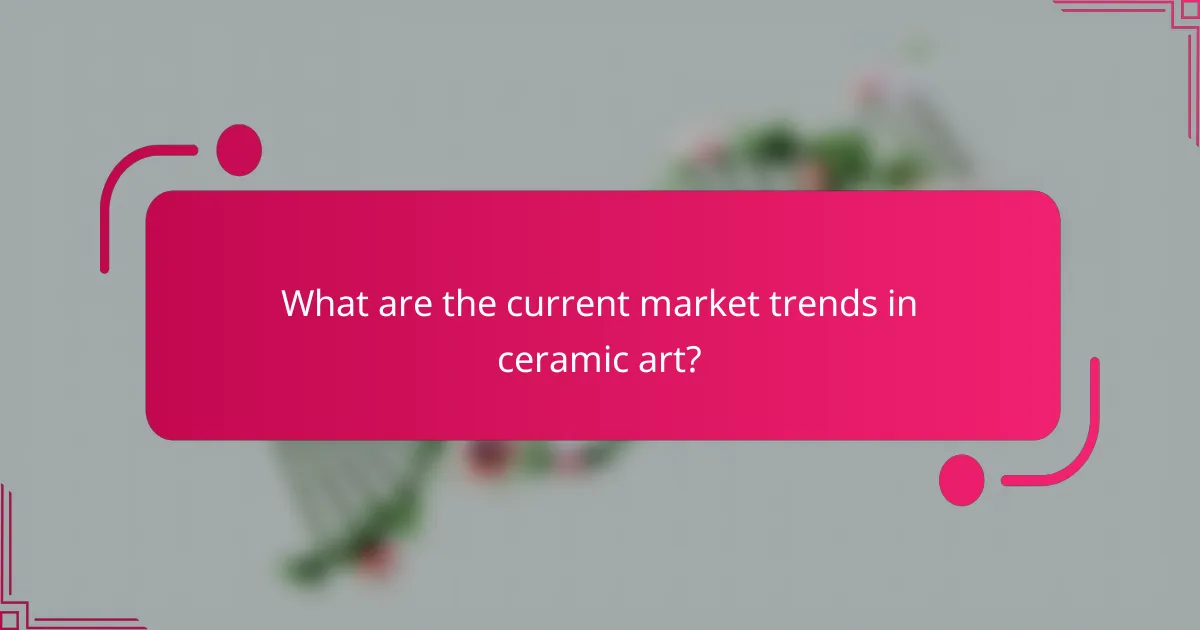
What are the current market trends in ceramic art?
Current market trends in ceramic art emphasize sustainability, innovative techniques, and a growing demand for unique, handcrafted pieces. Artists are increasingly using eco-friendly materials and methods, reflecting a consumer preference for sustainable art. Additionally, technology integration, such as 3D printing, is reshaping traditional practices, allowing for intricate designs and customization. The market is also seeing a rise in online platforms that connect artists directly with buyers, enhancing accessibility and broadening reach.
Which styles are gaining popularity among collectors in 2025?
In 2025, collectors are increasingly drawn to sustainable ceramic art, innovative glazing techniques, and functional designs. These styles reflect a growing awareness of environmental impact and a desire for unique, handcrafted pieces. The rise of interactive ceramics, which blend art with technology, is also gaining traction among enthusiasts.
How do cultural influences affect ceramic art markets globally?
Cultural influences significantly shape ceramic art markets globally by affecting design preferences and consumer values. For instance, local traditions inspire unique styles, while global trends promote sustainability. In Japan, the wabi-sabi aesthetic emphasizes imperfection, enhancing market appeal. Conversely, Western markets increasingly favor eco-friendly materials, reflecting a shift towards sustainability. This interplay drives innovation, as artisans blend traditional techniques with modern demands, creating diverse offerings that resonate across cultures.
What are the emerging platforms for selling ceramic art?
Emerging platforms for selling ceramic art include online marketplaces, social media, and specialized e-commerce sites. These platforms provide artists with wider audiences and innovative selling techniques.
1. Online Marketplaces: Sites like Etsy and Amazon Handmade cater specifically to artisans, offering user-friendly interfaces and built-in customer bases.
2. Social Media: Platforms such as Instagram and Pinterest allow artists to showcase their work visually, engage with audiences, and drive sales through direct links.
3. E-commerce Solutions: Websites like Shopify and Big Cartel enable artists to create personalized online stores, enhancing brand identity and customer experience.
4. Art Fairs and Pop-up Shops: These physical spaces allow artists to connect directly with buyers, fostering community and immediate sales.
5. Subscription Services: Platforms like Patreon enable artists to offer exclusive works or benefits to subscribers, creating a steady income stream.
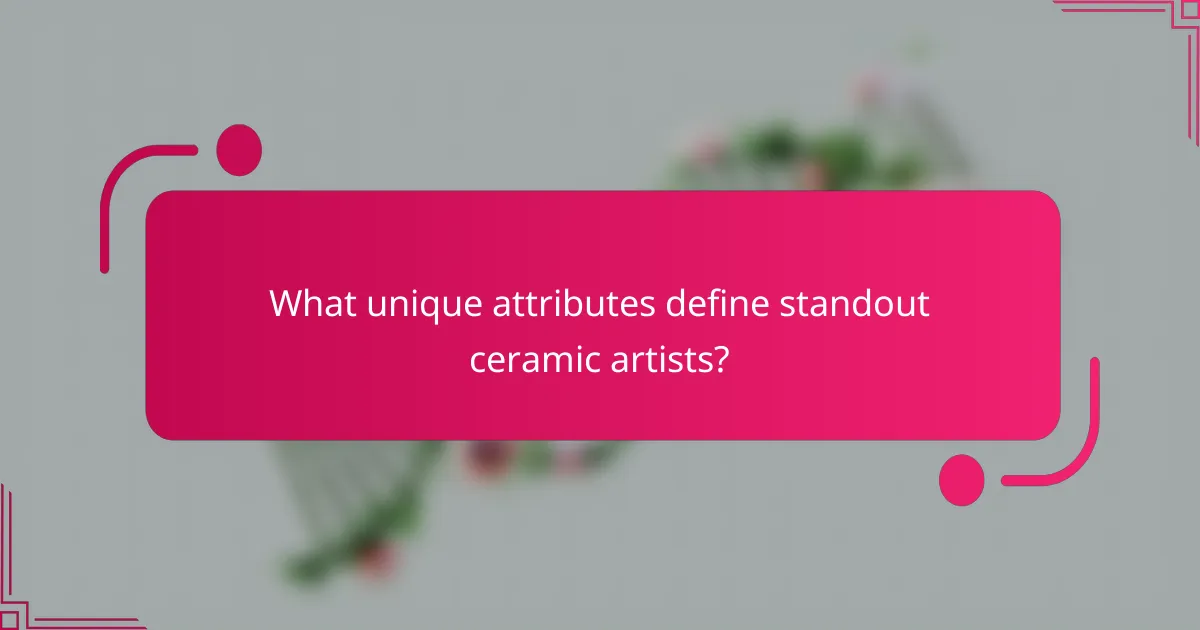
What unique attributes define standout ceramic artists?
Unique attributes of standout ceramic artists include innovative techniques, commitment to sustainability, and distinctive personal styles. Their ability to blend traditional methods with modern aesthetics sets them apart. Notably, some artists incorporate eco-friendly materials, reflecting a rare attribute in the industry. Additionally, their engagement with market trends allows them to create pieces that resonate with contemporary audiences. This fusion of creativity and environmental consciousness defines their unique contribution to ceramic art.
How does individual artistic vision influence ceramic innovation?
Individual artistic vision significantly drives ceramic innovation by introducing unique techniques and sustainable practices. Artists often experiment with materials and processes, leading to novel forms and styles. This creativity not only enhances aesthetic appeal but also addresses market trends towards eco-friendly ceramics. For instance, artists may incorporate recycled materials, reflecting a commitment to sustainability while pushing the boundaries of traditional ceramic art. Consequently, individual visions foster a dynamic landscape in the ceramic industry, blending personal expression with innovative practices.
Which rare techniques are being revived by contemporary artists?
Contemporary artists are reviving rare ceramic techniques such as sgraffito, raku firing, and slip casting. These methods enhance texture and color, offering unique artistic expressions. Sgraffito involves scratching through a surface to reveal a contrasting layer beneath, while raku firing creates unpredictable glazes through rapid cooling. Slip casting allows intricate shapes, showcasing innovation in ceramic art.
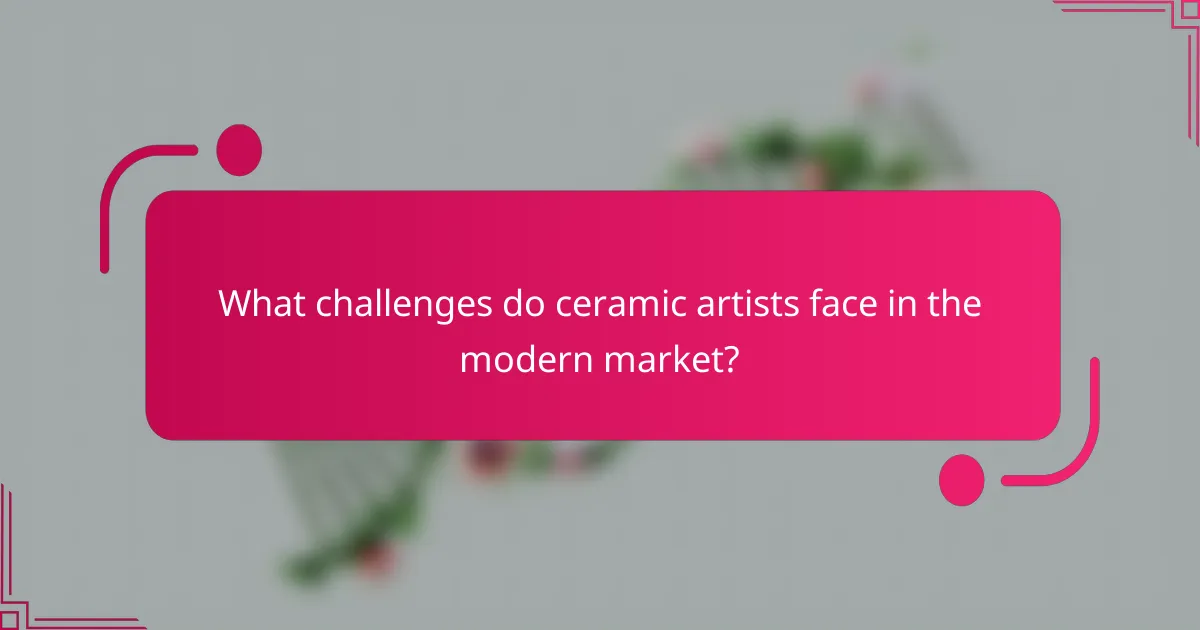
What challenges do ceramic artists face in the modern market?
Ceramic artists face several significant challenges in the modern market, including competition, sustainability, and market access. Competition from mass-produced ceramics pressures artists to differentiate their work. Sustainability concerns demand eco-friendly materials and practices, which can increase costs. Additionally, navigating online sales platforms and marketing strategies is essential for visibility in a crowded market. These challenges require artists to innovate continuously to stay relevant.
How do economic factors impact the ceramic art industry?
Economic factors significantly influence the ceramic art industry by affecting production costs, consumer demand, and market accessibility. Fluctuations in raw material prices can increase production expenses, impacting pricing strategies. Economic downturns may reduce disposable income, leading to decreased sales of non-essential items like ceramic art. Conversely, a thriving economy can boost consumer confidence and spending, fostering growth in this niche market. Additionally, globalization opens new markets for ceramic artists, while trade tariffs can hinder international sales. Overall, these factors shape the industry’s dynamics and innovation trends.
What are common misconceptions about ceramic art?
Common misconceptions about ceramic art include the belief that it is purely decorative and lacks functionality. Many assume that ceramics are fragile, yet advancements in materials have led to durable, functional pieces. Some people think only traditional techniques are valid, overlooking innovative methods like 3D printing. Additionally, there is a notion that ceramics are not environmentally friendly, while sustainable practices are increasingly adopted in the industry. Finally, many believe that ceramic art is only for a niche audience, whereas its appeal spans diverse markets and communities.
How can artists overcome barriers to entry in the ceramic market?
Artists can overcome barriers to entry in the ceramic market by leveraging innovative techniques, focusing on sustainability, and staying informed about market trends.
Emphasizing unique attributes, such as eco-friendly materials and contemporary designs, can attract consumers interested in sustainable art. Collaborating with established artists or brands can provide visibility and mentorship opportunities.
Additionally, utilizing social media platforms can enhance marketing efforts and expand reach. Participating in local art fairs and exhibitions allows artists to showcase their work directly to potential buyers.
Finally, continuous education in ceramic techniques and trends ensures artists remain competitive and adaptable in a dynamic market.
What best practices can ceramic artists adopt for success?
Ceramic artists can achieve success by embracing innovative techniques, prioritizing sustainability, and understanding market trends. Adopting mixed media approaches enhances creativity, while eco-friendly materials attract environmentally conscious consumers. Staying informed on market demands helps artists align their work with current trends, increasing sales opportunities. Networking with other artists and participating in exhibitions can also expand visibility and foster collaboration.
